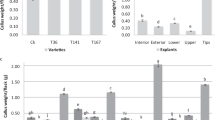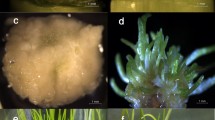Abstract
Twenty garlic Allium sativum (L.) genotypes were analysed for genetic variation in their ability to form callus (in one medium) and regenerate shoots (in four different media). Genotypes showed significant differences in the analysis of variance of all the traits tested. The accession Printanor showed the best general behaviour, with 83% callus-producing explants, 44.7% organogenic explants, and 15.35 shoots/g of callus. The best regeneration medium was MBO, without growth regulators. Shoot production capacity was examined with the additive main effects and multiplicative interaction model that proved to be a powerful tool for analysis and easy comprehension of the strong genotype×medium interactions frequently observed in in vitro culture systems.
Similar content being viewed by others
Author information
Authors and Affiliations
Additional information
Received: 5 February 1998 / Revision received: 11 May 1998 / Accepted: 1 June 1998
Rights and permissions
About this article
Cite this article
Barandiaran, X., Martín, N., Rodríguez-Conde, M. et al. Genetic variability in callus formation and regeneration of garlic (Allium sativum L.). Plant Cell Reports 18, 434–437 (1999). https://doi.org/10.1007/s002990050599
Issue Date:
DOI: https://doi.org/10.1007/s002990050599




